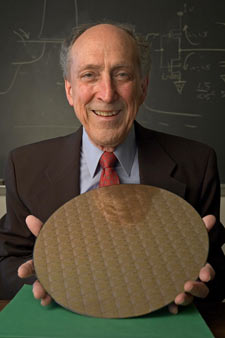
We quote the size of the RAM on our computer as a quick way of stating its speed, its power, its performance potential. Often taken for granted today, the power to store huge amounts of information on a microscopic chip was, in fact, a key enabler of the electronics industry, making computers—not to mention cell phones, digital cameras, MP3 players, and the like - fast, affordable, small, and efficient. This chip has become ubiquitous due to Robert Dennard. A researcher with IBM, Dennard invented the dynamic Random Access Memory (RAM) chip in 1967—a type of chip that, despite the accelerating technology of the computer industry, remains the standard today.
Born in Texas in 1932, Dennard earned a band scholarship to attend Southern Methodist University where he received his undergraduate and master's degrees in electrical engineering. He went on to get his Ph.D. from the Carnegie Institute of Technology (now Carnegie Mellon University) and signed up for a job at IBM in 1958—a job he took just to get his feet wet, planning only to stay a few years. Dennard's team at IBM focused on memory cells that relied on the contemporary standard of six transistors to keep track of each bit of data. Instead, Dennard had the idea that binary information could be stored as a positive or negative charge on a capacitor. The only hitch was that capacitors leak the charge off in milliseconds, so Dennard devised a configuration where a single transistor could read the charge and put it back thousands of times per second. A single transistor would then be responsible for each bit of information, thus reducing the size of the whole cell dramatically. The constant refreshing of the charge on each capacitor is why Dennard's chip is referred to as "dynamic" RAM.
The idea of a memory chip that couldn't "remember" anything for longer than a heartbeat sounded a little absurd when Dennard first announced it to his colleagues, but the smaller chip was certainly more efficient than any previous memory device. By the mid 1970s, they were integral to almost all computers. Today's DRAM chips are even smaller and faster, but the basic principle remains the same.
After inventing his chip, Dennard and his team went on to help industries decide in which kind of transistors to invest research time by developing a scaling theory concerning the metal-oxide field effect transistor (MOSFET). He showed that by reducing all dimensions of a MOSFET while also reducing operating voltage and silicon doping concentration, engineers could make smaller and smaller devices that performed better and better. This vision to create ever-smaller and faster devices has become a driving force of the microelectronics industry.
Dennard continues to work at IBM. He has found that while the early chips always became more efficient when made smaller, additional physics effects provide complications on the tiniest of chips used today. Making them smaller no longer provides a great jump in speed. Dennard knows there will have to be another breakthrough to get around those limits, so he's not ready to quit trying.
Over the years, he has earned 37 patents, and numerous honors for his work, including the National Medal of Technology (1988), the Harvey Prize from Technion - Israel Institute of Technology (1990), the IEEE Edison Medal (2001), and the Lemelson-MIT Lifetime Achievement Award (2005). He was also inducted into the National Inventors Hall of Fame in 1997.
Information as of April 2007

